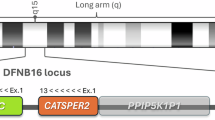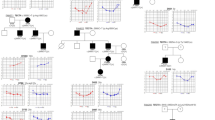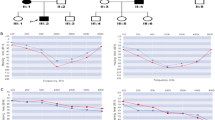Abstract
Autosomal dominant hearing loss is highly heterogeneous. Hearing impairment mainly involves the mid-frequencies (500–2000 Hz) in only a low percentage of the cases. In a Dutch family with autosomal dominant mid-frequency/flat hearing loss, genome-wide SNP analysis combined with fine mapping using microsatellite markers mapped the defect to the DFNA8/12 locus, with a maximum two-point LOD score of 3.52. All exons and intron–exon boundaries of the TECTA gene, of which mutations are causative for DFNA8/12, were sequenced. Only one heterozygous synonymous change in exon 16 (c.5331G>A; p.L1777L) was found to segregate with the hearing loss. This change was predicted to cause the loss of an exonic splice enhancer (ESE). RT-PCR using primers flanking exon 16 revealed, besides the expected PCR product from the wild-type allele, a smaller fragment only in the affected individual, representing part of an aberrant TECTA transcript lacking exon 16. The aberrant splicing is predicted to result in a deletion of 37 amino acids (p.S1758Y/G1759_N1795del) in α-tectorin. Subsequently, the same mutation was detected in two out of 36 individuals with a comparable phenotype. Owing to the position of the protein deletion just N-terminal of the zona pellucida (ZP) domain of α-tectorin, it is likely that the deletion of 37 amino acids may affect the proteolytic processing, structure and/or function of this domain, which results in a clinical phenotype comparable to that of missense mutations in the ZP domain. In addition, this is the first report of a synonymous mutation that affects an ESE and causes hereditary hearing loss.
Similar content being viewed by others
Log in or create a free account to read this content
Gain free access to this article, as well as selected content from this journal and more on nature.com
or
References
Kochhar A, Hildebrand MS, Smith RJ : Clinical aspects of hereditary hearing loss. Genet Med 2007; 9: 393–408.
Huygen PL, Pauw RJ, Cremers CW : Audiometric profiles associated with genetic non-syndromal hearing impairment: a review and phenotype analysis. In Alessandro Martini (ed): Genes, Hearing and Deafness. London: Informa Healthcare, 2007, pp 185–204.
Modamio-Hoybjor S, Mencia A, Goodyear R et al: A mutation in CCDC50, a gene encoding an effector of epidermal growth factor-mediated cell signaling, causes progressive hearing loss. Am J Hum Genet 2007; 80: 1076–1089.
Plantinga RF, de Brouwer AP, Huygen PL, Kunst HP, Kremer H, Cremers CW : A novel TECTA mutation in a Dutch DFNA8/12 family confirms genotype-phenotype correlation. J Assoc Res Otolaryngol 2006; 7: 173–181.
Miller SA, Dykes DD, Polesky HF : A simple salting out procedure for extracting DNA from human nucleated cells. Nucleic Acids Res 1988; 16: 1215.
Gudbjartsson DF, Jonasson K, Frigge ML, Kong A : Allegro, a new computer program for multipoint linkage analysis. Nat Genet 2000; 25: 12–13.
Hoffmann K, Lindner TH : easyLINKAGE-Plus – automated linkage analyses using large-scale SNP data. Bioinformatics 2005; 21: 3565–3567.
de Heer AR, Pauw RJ, Huygen PLM, Collin RWJ, Kremer H, Cremers CWRJ : Flat threshold and midfrequency hearing impairment in a Dutch DFNA8/12 family with a novel mutation in TECTA. Some evidence for protection of the inner ear.Audiol Neurootol (submitted).
Blencowe BJ : Exonic splicing enhancers: mechanism of action, diversity and role in human genetic diseases. Trends Biochem Sci 2000; 25: 106–110.
Cooper TA, Mattox W : The regulation of splice-site selection, and its role in human disease. Am J Hum Genet 1997; 61: 259–266.
Valentine CR : The association of nonsense codons with exon skipping. Mutat Res 1998; 411: 87–117.
Hertel KJ, Lynch KW, Maniatis T : Common themes in the function of transcription and splicing enhancers. Curr Opin Cell Biol 1997; 9: 350–357.
Legan PK, Rau A, Keen JN, Richardson GP : The mouse tectorins. Modular matrix proteins of the inner ear homologous to components of the sperm-egg adhesion system. J Biol Chem 1997; 272: 8791–8801.
Richardson GP, Russell IJ, Duance VC, Bailey AJ : Polypeptide composition of the mammalian tectorial membrane. Hear Res 1997; 25: 45–60.
Legan PK, Lukashkina VA, Goodyear RJ et al: A deafness mutation isolates a second role for the tectorial membrane in hearing. Nat Neurosci 2005; 8: 1035–1042.
Legan PK, Lukashkina VA, Goodyear RJ, Kossi M, Russell IJ, Richardson GP : A targeted deletion in alpha-tectorin reveals that the tectorial membrane is required for the gain and timing of cochlear feedback. Neuron 2000; 28: 273–285.
Meyer NC, Alasti F, Nishimura CJ et al: Identification of three novel TECTA mutations in Iranian families with autosomal recessive nonsyndromic hearing impairment at the DFNB21 locus. Am J Med Genet A 2007; 143: 1623–1629.
Mustapha M, Weil D, Chardenoux S et al: An alpha-tectorin gene defect causes a newly identified autosomal recessive form of sensorineural pre-lingual non-syndromic deafness, DFNB21. Hum Mol Genet 1999; 8: 409–412.
Naz S, Alasti F, Mowjoodi A et al: Distinctive audiometric profile associated with DFNB21 alleles of TECTA. J Med Genet 2003; 40: 360–363.
Verhoeven K, Van Laer L, Kirschhofer K et al: Mutations in the human alpha-tectorin gene cause autosomal dominant non-syndromic hearing impairment. Nat Genet 1998; 19: 60–62.
Govaerts PJ, De Ceulaer G, Daemers K et al: A new autosomal-dominant locus (DFNA12) is responsible for a nonsyndromic, midfrequency, prelingual and nonprogressive sensorineural hearing loss. Am J Otol 1998; 19: 718–723.
Iwasaki S, Harada D, Usami S, Nagura M, Takeshita T, Hoshino T : Association of clinical features with mutation of TECTA in a family with autosomal dominant hearing loss. Arch Otolaryngol Head Neck Surg 2002; 128: 913–917.
Kirschhofer K, Kenyon JB, Hoover DM et al: Autosomal-dominant, prelingual, nonprogressive sensorineural hearing loss: localization of the gene (DFNA8) to chromosome 11q by linkage in an Austrian family. Cytogenet Cell Genet 1998; 82: 126–130.
Alloisio N, Morle L, Bozon M et al: Mutation in the zonadhesin-like domain of alpha-tectorin associated with autosomal dominant non-syndromic hearing loss. Eur J Hum Genet 1999; 7: 255–258.
Balciuniene J, Dahl N, Jalonen P et al: Alpha-tectorin involvement in hearing disabilities: one gene – two phenotypes. Hum Genet 1999; 105: 211–216.
Pfister M, Thiele H, Van Camp G et al: A genotype-phenotype correlation with gender-effect for hearing impairment caused by TECTA mutations. Cell Physiol Biochem 2004; 14: 369–376.
Coutinho P, Goodyear R, Legan PK, Richardson GP : Chick alpha-tectorin: molecular cloning and expression during embryogenesis. Hear Res 1999; 130: 62–74.
Acknowledgements
We gratefully acknowledge all the individuals who participated in this study and thank R Ensink, S van der Velde-Visser, C Beumer and K Voesenek for technical assistance. This study was financially supported by the European Commission FP6 Integrated Project EUROHEAR; contract number: LSHG-CT-20054-512063, by the ARHI KP6 Project; contract number: QLRT-2001-00331 and by the Heinsius Houbolt Foundation.
Author information
Authors and Affiliations
Corresponding author
Rights and permissions
About this article
Cite this article
Collin, R., de Heer, AM., Oostrik, J. et al. Mid-frequency DFNA8/12 hearing loss caused by a synonymous TECTA mutation that affects an exonic splice enhancer. Eur J Hum Genet 16, 1430–1436 (2008). https://doi.org/10.1038/ejhg.2008.110
Received:
Revised:
Accepted:
Published:
Issue date:
DOI: https://doi.org/10.1038/ejhg.2008.110
Keywords
This article is cited by
-
Novel loss-of-function mutations in COCH cause autosomal recessive nonsyndromic hearing loss
Human Genetics (2020)
-
A comparative analysis of genetic hearing loss phenotypes in European/American and Japanese populations
Human Genetics (2020)
-
Deciphering the evolutionary signatures of pinnipeds using novel genome sequences: The first genomes of Phoca largha, Callorhinus ursinus, and Eumetopias jubatus
Scientific Reports (2018)
-
Research progress in pathogenic genes of hereditary non-syndromic mid-frequency deafness
Frontiers of Medicine (2016)
-
A novel mutation of EYA4 in a large Chinese family with autosomal dominant middle-frequency sensorineural hearing loss by targeted exome sequencing
Journal of Human Genetics (2015)



